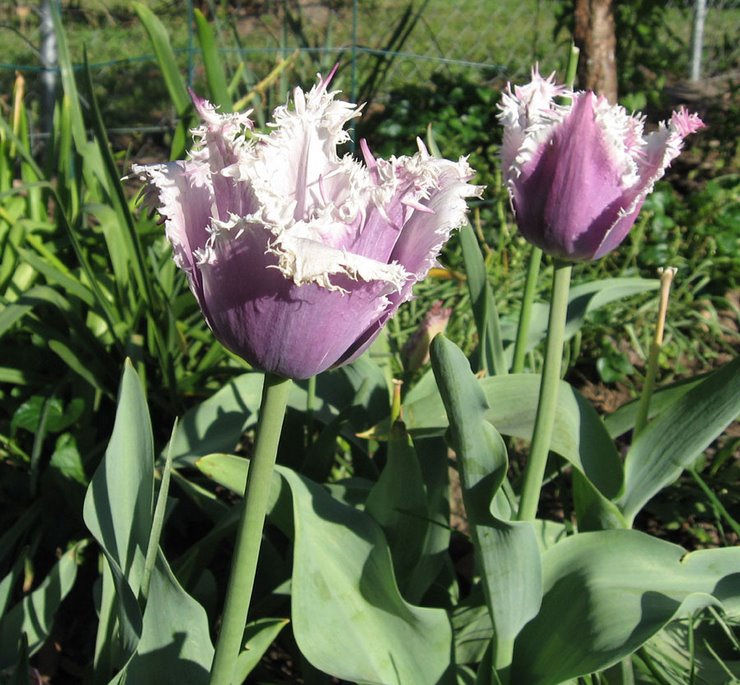If you've been wishing you'd started feeding hummingbirds earlier this year, now might be a good time to start. By this point, they are done with nesting, and are feeding a lot as they get ready for migration. It's an incredibly long flight for these tiny birds, and they need to double their body weight before they begin. Putting up a hummingbird feeder now might get them started visiting your yard.
In hot summer weather, you'll need to clean and refill your hummingbird feeder every two or three days so the nectar won't go bad. Nectar is one part sugar and four parts water. Don't use honey or artificial sweeteners, only real sugar. You don't need to add any coloring to the nectar, and food coloring isn't good for the birds. Hummingbirds are attracted to the color red, but most nectar feeders have red parts; the color doesn't need to be in the nectar. If you want to add more red to draw them in, you could tie a red ribbon on the feeder or a nearby tree or shrub. The color and movement of the ribbon may attract the attention of passing hummingbirds, and entice them to visit your yard.
I hang my feeder in a shady area, which helps in two ways: the nectar stays better in hot weather, and it's one of the things recommended to discourage bees. Be sure to wipe off any drips of the nectar, as this will attract insects.
Of all the hummingbird feeders I've had over the years, the one pictured above is my favorite. It's not only easy to clean, but has been pretty bee-resistant. With previous feeders, bees and wasps were always hanging around to feed. I also use an ant moat when hanging the feeder, and highly recommend them. The moat is a small cup with water so that ants can't crawl down onto the feeder.
If you start having a lot of trouble with bees and wasps at your feeder, here are some suggestions. Be sure you aren't making your nectar sweeter than the recommended one part sugar/four parts water mix. Some people dilute it a bit further, like 1:5 for a while to discourage bees. Some feeders have bee guards at each feeding port that keep bees from being able to reach the nectar. The color yellow tends to attract bees and wasps, so a feeder that doesn't have any yellow may help. You might also set up a diversion feeder for the bees, with a 1:3 nectar mix in a shallow yellow bowl for them. At first set it up near your hummingbird feeder, then gradually move the feeder away. If you move the hummingbird feeder a few feet away from its original location, the birds will find it, but the insects may have more trouble.
According to the Cornell Lab of Ornithology website, a saucer-style feeder, where the nectar is below the feeding ports, tends to be best for discouraging bees. The hummingbirds can reach the nectar with their long tongues, but bees and wasps can't reach it. These feeders don't drip nectar like some other types do. Just wipe off any spilled nectar each time you rehang it. It may also help to spray it down with plain water to remove any traces of sugar.
Never use insecticides, repellents, sticky tape or oils around the feeder to repel insects, as these things will harm the hummingbirds. If oil, cooking spray or petroleum jelly gets on the hummer's feathers, it can mat down their feathers, making it harder to fly, or can even cause hypothermia.
Be sure that you clean your feeder thoroughly with hot water so that mold doesn't begin to grow. Take the feeder apart, and soak the pieces in hot water, then scrub with a bottle brush. I also have a great little brush designed for cleaning feeders that can reach inside the feeding ports and all the little crevices. If you use a tiny bit of soap in your hot water, be sure you rinse every trace of soap off before reassembling the feeder. Clean your feeder consistently--if hummingbirds find sour or moldy nectar in your feeder, they'll go somewhere else, and may not be back.
Hummingbirds at this time of year tend to be protective of food sources, so they may chase away other hummers that approach a feeder. Using multiple feeders helps. Hang feeders so that they are out of view of each other.
If you put out mesh bags of fruit or banana peels they will attract fruit flies, which is another favorite food source of hummingbirds. They will also be drawn to flowers that provide nectar. Some of their favorites include bee balm, honeysuckle, trumpet creepers, columbine, goldenrod, salvia and phlox.
It would also help attract hummingbirds to offer a source of fresh water. A regular birdbath tends to be much too large and deep for them. Adding stones to a birdbath or saucer may make water shallow enough for them. Hummingbirds especially like water that is sprayed in a fine mist. You can get misters that fit on a garden hose. Pin-hole openings shoot out a fine mist of water into the air. Hummingbirds will zip back and forth through the spray to bathe. They will also rub against plant leaves that have been wet by the spraying water.


1 comment:
Appreciated this post. I would love to add a mister to my garden in addition to the feeder to make a nicer welcome for the hummingbirds migrating through our NE Kansas property.
Post a Comment